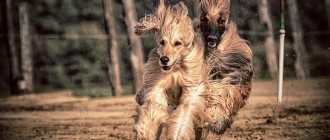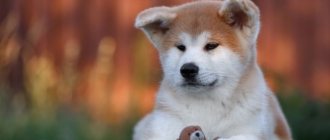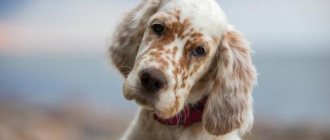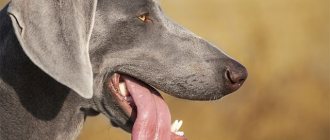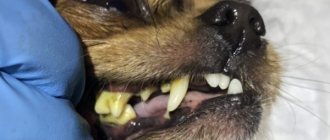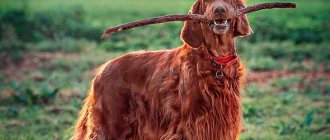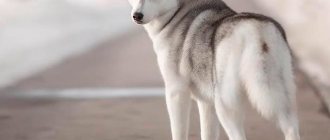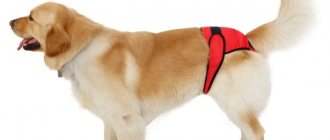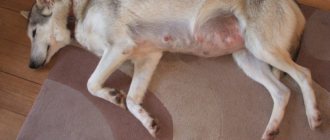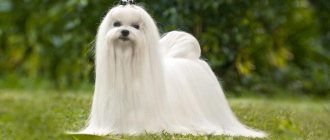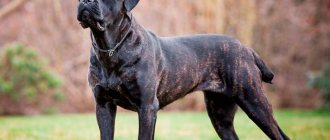The Chow Chow is an amazing dog with a blue tongue. It is one of the most ancient breeds that have undergone almost no selection. The unusual appearance and proud appearance immediately attracts attention. Their calm nature makes these dogs popular companions. But this pet is not suitable for everyone. Before getting a dog of this breed, you need to study its description, pros and cons, and reviews from owners.
- Head
- Education and training
- Nutrition
Breed traits
Breed traits (on a 5-point scale)
| Chow chow | |||
| Activity | in the house | 2.5 | |
| on the street | 3 | ||
| Obedience | training | 2.5 | |
| strangers | 3.6 | ||
| Domination | in family | 3.7 | |
| over dogs | 4.3 | ||
| Defending your territory | from people | 4.5 | |
| from dogs | 4.5 | ||
| Sociability | in family | 3.5 | |
| with strangers | 1.7 | ||
| with dogs | 2 | ||
| Concentration | in family | 2.7 | |
| in front of strangers | 4 | ||
| with dogs | 3.7 | ||
| Aggressiveness | in family | 2.7 | |
| to strangers | 4.1 | ||
| to the dogs | 4 | ||
| to cats | 3.9 | ||
| Family behavior | calmness | 3 | |
| demand for affection | 2.9 | ||
| excitability | 3.2 | ||
| playfulness | 2.8 | ||
| excessive barking | 1.7 | ||
| behavioral breakdowns | 2 | ||
| Tolerance for children | up to 4 years | 2.2 | |
| over 4 years old | 2.3 | ||
| Institutional use | watchman | 4.4 | |
| bodyguard | 4.2 | ||
This breed is often compared to the following dog breeds: Akita Inu, Samoyed, German Shepherd, Shar Pei, Labrador Retriever.
Photos show what chow chows look like:
Behavior in a team
"Buddha's Helpers" are unfriendly to strangers and other animals. But the owner is their closest friend, and they devote themselves to him with all their hearts.
This trait, by the way, has a strong effect when a new pet appears. Wayward dogs are not always ready to accept it. For example, they will never come to terms with the appearance of a cat in the family, but they will be able to find a common language with a dog, but only if they grew up together. The best option for a second pet may be another representative of this breed, but always of the opposite sex.
Do not worry about the relationship between the chow chow and the child in the family. Plush pets are favorable towards children, although they prefer loneliness or communication with other dogs to playing together.
Characteristics of the Chow Chow breed
The Chow Chow is an ancient Chinese breed of dog. Known in this country for more than 2 thousand years. It belongs to the Spitz group, but many researchers note its relationship with the Tibetan mastiffs. For a long time, representatives of the breed did not cross with other dogs, therefore they retained the appearance and character traits of their ancestors.
Previously, they were used to protect homes and property, transport goods, herd livestock, and hunt. These dogs helped people in everything, became devoted companions and faithful protectors. Now this breed is kept as a pet, although it has retained its working qualities.
Chow Chows are easy to recognize; these dogs resemble a teddy bear. Appearance features include a luxurious mane, a large head and a purple tongue. By nature they are independent, stubborn and self-confident. Because of their unusual gait and serious expression on their faces, they are called aristocrats. Another feature inherent in this breed is that Chow Chows choose their owner at an early age and remain devoted to him all their lives.
| options | characteristic |
| breed name | chow chow |
| country of origin | China |
| group of breeds according to the ICF classification | Spitz |
| year of registration | 1895 |
| life expectancy | 9-12 years |
| height | females 46-51 cm, males 48-56 cm |
| weight | females 20-27 kg, males 25-32 kg |
| working qualities | watchman, guard, hunter, companion |
| activity | lazy in hot weather, become active in winter |
| attitude towards people | suspicious, but not aggressive, become attached to one owner and do not tolerate loneliness well |
| intelligence | smart, but difficult to train |
| difficulty of care | They shed a little, but the coat is not easy to care for |
| noise | almost no bark |
| health | average |
Name
Previously, this breed was called the “barbarian dog”, “Tatar dog”. The name Chow Chow appeared in England after registration at the end of the 19th century. There are several versions of its origin. Usually chow chow is translated as “dog - shaggy lion.” But you can associate this word with the name of the place on the ship where cargo is transported or with the designation of all Chinese, popular at that time in England. If you turn to the Chinese language, you can find several similar words: “kau” is translated as “dog”, and “chaow” is a strong and brave dog.
Why does the Chow Chow have a blue tongue?
The main feature of the Chow Chow is its purple tongue. This breed differs from all others. There is no scientific explanation for this phenomenon. This is an ancient breed, and these dogs have had a dark tongue for a long time. There are several versions explaining the reason for this coloring:
- it came from the ancient polar wolves, who were the ancestors of the chow chow;
- the blue tongue came from bears, with which many researchers associate the breed;
- The ancestors of the Chow Chow came to China from the Arctic, where there was a lack of oxygen, which affected the color of the tongue;
- According to legend, during the creation of the world, a piece of the sky fell to the ground and the chow chow licked it.
The color of the tongue can change at different times of the day from light blue to purple and almost black. When the dog is worried or hot, it brightens. The color depends on the health of the animal and age. Puppies are born with pink tongues. It turns blue in about a month. The older the dog, the darker the color.
The photos show the color of the chow chow tongue:
Pros of the breed
Due to its medium size and calm temperament, the Chow Chow is suitable for living in an apartment. These dogs have many advantages:
- the main advantage is the original and luxurious appearance;
- thanks to the special structure of wool, it is capable of self-cleaning, does not tangle and does not smell;
- these dogs are silent, bark very rarely;
- clean, do not like to walk in mud;
- devoted and faithful, attached to one owner;
- have watchdog and security qualities;
- sense a person’s mood and are ready to help;
- rarely show aggression towards strangers and other animals, the attitude is usually neutral;
- calm, do not require long and active walking.
Cons of the breed
This breed is not suitable for everyone. Chow chows have disadvantages that can make keeping them difficult:
- independence and stubbornness interfere with training;
- the coat requires serious care;
- early socialization and education are necessary;
- becomes attached to only one owner, does not show warm feelings towards other family members;
- for the same reason, he listens to only one person, who will become an authority for the dog, and does not like to obey others;
- A dog of this breed needs to be bought at an early age, they choose an owner for life, and then they cannot get used to another.
What to do if your dog's tongue turns blue when it should be pink
If the tongue turns purple in someone other than the Chow Chow, Shar Pei or Eurasier, the owner should immediately take his pet to the veterinarian. The fact is that darkening of the oral cavity (tongue, palate, gums) is cyanosis associated with a serious narrowing of the vascular lumen and a critical lack of oxygen in the arterial blood. The pathological condition occurs in diseases of the respiratory and cardiovascular systems.
Table: what diseases cause cyanosis
| Cause of darkening of a dog's tongue | What diseases can lead to cyanosis | Associated symptoms |
| Oxygen starvation due to decreased pulmonary ventilation | Obstructive bronchitis, bronchial asthma, atelectasis, pneumonia, pulmonary edema and injury, hypertrophy of the velum, etc. | The animal is apathetic, refuses food and water, and there is shortness of breath and wheezing. |
| Insufficient blood output due to pathology of the cardiovascular system | Cardiomyopathy, myocarditis, atrial or ventricular septal defect, tetralogy of Fallot, etc. | Heavy breathing with wheezing, cough, increased salivation, irregular heart rhythm. |
How are diseases that cause darkening of a dog's tongue treated?
Treatment depends on the exact disease causing the cyanosis. To make a diagnosis, it is necessary to undergo a full examination: take clinical and biochemical blood tests, give the dog an ECG (electrocardiography), ECHO (ultrasound of the heart) and a chest x-ray. Some pathologies cannot be completely eliminated (for example, cardiomyopathy) - the veterinarian can only prescribe supportive therapy that will help eliminate symptoms and prevent complications. The owners cannot hope that the condition will normalize on its own. All diseases that cause darkening of the tongue are dangerous and require immediate treatment. Delay may cause the death of the animal.
The presence of cyanosis always means that the dog’s body does not have enough oxygen, and this is life-threatening - the owner’s task is to deliver the animal to the clinic as quickly as possible
Only owners of Shar Peis, Chow Chows and Eurasians need not worry about their dogs having purple tongues. Such pigmentation in representatives of these breeds is a gift from nature. Coloring the tongues of other dogs in dark shades is already a sign of a serious pathology, if which appears, you should immediately take your pet for diagnosis to a veterinary clinic.
History of the origin of the Chow Chow breed
The Chow Chow breed is ancient, bred in China for more than 2 thousand years. It is believed that similar dogs lived in the imperial palace back in the 3rd millennium BC. e. But there is no reliable information about the origin of the breed and how it came to China. Researchers call the ancestors of the chow chow polar wolves, bears, huskies, and Tibetan mastiffs. It is believed that such dogs were brought to China from Siberia. This is indicated by a thick coat and the ability to withstand harsh weather conditions.
At first, dogs of this breed were kept in the houses of rich nobles and in monasteries. Then they spread throughout the country. The Chinese bred Chow Chows to protect their herds and homes. They endowed these dogs with magical properties and believed that they could save their owners from evil spirits.
The breed came to Europe only at the end of the 18th century. At first they were perceived as wild, exotic animals. Only 100 years later, Chow Chows began to be bred in Great Britain. In 1895, the first breed club appeared and a standard was adopted.
Shar Pei
There is also a legend about the origin of the blue-black tongue of the Shar Pei. There lived two brothers: Shar and Pei. One day Shar stole a skin from Pei. Pei chased after Shar, but he ran and looked around, sticking his tongue out at his brother. At some point, Pei tripped and bit his tongue, which remained blue-black forever.
According to the breed standard, the Shar Pei's tongue, palate and gums are preferably bluish-black.
Description of the appearance of representatives of the Chow Chow breed
The Chow Chow is a medium-sized dog, height 46-56 cm. The body is harmonious, square, an adult dog weighs 20-30 kg. Because of the thick fur, it appears larger than it actually is.
Head
The head is large and wide. The skull is flat, the stop is blurred. The muzzle is wide, not pointed. The folds give her a frowning expression. The nose is large and black. Scissor bite, upper jaw larger than lower jaw. Cheeks droop. The color of the palate and gums is dark.
The eyes are medium in size, deep-set, making them appear smaller. Located close to each other. The color is usually dark, but may match the coat color. The ears are small, almost invisible in the thick fur, and set wide apart. Thick, triangular in shape, rounded at the ends. They stand and lean forward a little.
Frame
The neck is short, powerful, gracefully curved. The back is straight, short, the loin is wide. The chest is deep and wide. The tail is set high, carried up and carried over the back. Should not bend like a ring.
Limbs
The limbs are straight, with strong bones. The shoulder blades are wide, close together, and the elbows are directed back. The joints are minimally pronounced. The paws are small and round. Due to these structural features, the Chow Chow has an unusual gait. They walk in small steps, as if on stilts. The movements are rhythmic. These dogs cannot run fast, but are very resilient.
Wool
The coat is very thick and long. The guard hair is straight and coarse. The undercoat is soft and dense. There is a characteristic lion's mane on the neck, feathering on the legs.
There is another variety of Chow Chow – shorthaired. It's called smooth. Their fur is very thick, plush to the touch, and the hairs are arranged vertically.
Color
The color of the dog must be uniform. Previously, only black and blue Chow Chows were bred. Now the standard allows brown, cinnamon (cinnamon color), red, white, cream. There should be no stains. Red and cinnamon colors are the most common. But blue and white are more valuable.
Photos complement the description of the appearance of these dogs:
Variety of colors
The titular purple-tongued dog is a breed that comes in five coat colors:
- Red. It is possible to dye the wool in dark wood tones; golden and yellow tones are allowed. Light spots on the coat are located on the tail, paws and neck. Puppies have a dark muzzle, which changes with age and acquires an even color.
- Black. As a rule, representatives of this color have an even color. There may be a silver tint on the tail. If kept outdoors for a long time, the color of the coat may become rusty.
- Cream. The most common representatives of the breed are beige, close to white. The peculiarity of this color is that with age the wool can change its color to yellow-brown. Over time, the nose becomes not blue, but brown.
- Blue. The Chow Chow dog of this color has a deep blue color, with silver tints possible. The nose can be either gray or black. The only requirement for this purple-tongued dog is that it must not have a brown nose.
- Tsimt. This color is characterized by white and beige tones, possibly pinkish and gray. A special feature of this coat color is the presence of a grayish muzzle.
Character traits
Due to their appearance, Chow Chows look menacing and gloomy. But in reality they are not aggressive and cheerful. They become attached to the owner and are friendly with other family members, but do not like familiarity. They get along well with children, but will not tolerate it if a child hurts them.
These dogs always behave in a reserved manner; they are introverts by nature. They never show violent feelings. Joy is expressed by a slight twitch of the tail, sometimes whining. They do not understand excessive emotionality in humans, but they are able to sense the mood of the owner. In a dangerous situation, the dog will not hesitate to rush to defense, even if he has not been trained to do so.
They treat strangers with caution, but without aggression. They get along well with pets if they grow up with them. They just don't tolerate other dogs in the house. They may chase other people's cats on the street.
Representatives of this breed have the following character traits:
- pride;
- stubbornness;
- independence;
- self-sufficiency;
- touchiness;
- loyalty;
- equilibrium;
- restraint.
Education and training
The Chow Chow is a very intelligent dog with a good memory, but its independent nature and innate stubbornness make it difficult to train. She is prone to dominance and will only listen to someone who has been able to gain authority from her. The dog carries out commands reluctantly, sometimes after much thought. If he doesn’t understand why he should sit in one position or jump for a long time, he won’t do it.
It will take a lot of patience to train a Chow Chow. It is especially difficult to raise a male dog, as they are very prone to dominance. When training, it is advisable to follow the recommendations of dog handlers:
- you cannot indulge your pet’s whims, prohibitions must be consistent, all family members must adhere to the same requirements;
- this dog must be treated with respect, the main method of training should be treats, affection and praise;
- rudeness is unacceptable, these dogs react poorly to violence, are touchy and may lose interest in activities;
- Early socialization is important; the puppy needs to be accustomed to street noise, strangers, and cars.
You yourself need to learn the basic commands with your dog: “sit”, “lie down”, “place”, “come to me”, “no”, “near”. More serious training is recommended under the guidance of an experienced dog handler.
Visit to the veterinarian
At the appointment, the veterinarian examines the four-legged animal, listens to its chest and checks its heart function. To do this, he uses the following research:
- auscultation, detecting extraneous noise;
- pulse oximetry, which measures the degree of oxygen saturation in the blood;
- urine and blood tests to detect concomitant disorders;
- ECG, which determines heart rhythm;
- Ultrasound and x-rays that reveal pathological changes inside the lungs and heart.
The doctor may supplement the standard list with pleural puncture, bronchoalveolar lavage, or other studies. The final amount depends on the difficulty of identifying the main cause of the ailment.
Caring for Chow Chow Dogs
The Chow Chow is a dog that can be kept both in a city apartment and in a private house. Although its thick coat allows it to withstand harsh weather conditions, it is not suitable for outdoor living. You can’t put her in an enclosure or on a chain; she needs constant human attention. It is necessary to provide the dog with coolness in the summer, as it does not tolerate heat well.
Walking a chow chow for 1-3 hours a day is enough. These dogs need exercise, but it is important to note that they do not like to run. It is advisable to walk this dog on a leash; he may run after a cat or bird. In rainy weather, you need to take your pet out in waterproof overalls so that you don’t have to bathe it. It is not recommended to use a wide collar; it will wipe out the fur on the neck. It is better to wear a narrow leather one or a harness. In summer, it is necessary to take him outside early in the morning and in the evening, when there is no extreme heat.
When caring for a Chow Chow, you need to adhere to the following rules:
- brush daily, and carefully comb the coat several times a week with a long-toothed comb;
- after a walk, wash your paws, wipe your stomach and sides with a damp towel;
- every other day, examine your eyes and remove discharge with a cotton pad;
- Clean your ears from dirt and wax a couple of times a month, use cotton pads soaked in boiled water or a special lotion;
- Trim nails with a nail clipper once a month;
- trim six on the paws and between the toes;
- brush your teeth every week with veterinary paste;
- treat fur for fleas and ticks every 3 months;
- bathe no more than 2-3 times a year using shampoo for long-haired dogs.
Nutrition
Premium or super-premium food is suitable for chow chows. They should be low in protein and fat, without synthetic additives. It is better to choose food designed for animals with allergies or sensitive digestion. Happy Dog, Grandorf, Acana, Brit brands are suitable. If your pet has health problems, it is better to choose food on the recommendation of a veterinarian.
Chow chows are prone to obesity, so they should not be overfed or given kibble or food from the human table. An adult dog should be fed twice a day, at the same time every day.
When feeding natural food, the diet should contain the following products:
- lean meat - chicken, turkey, rabbit, veal;
- sea fish;
- rice or buckwheat porridge;
- raw vegetables.
You can add 1 teaspoon of sunflower oil to prepared dishes. Egg yolk and fermented milk products are useful. You should not give fatty and fried foods, spicy, salty foods, marinades and semi-finished products. Sweets, legumes, and baked goods are prohibited.
Health
These dogs are in good health, but there are several pathologies to which they are prone:
- dysplasia of the hip or elbow joints;
- turning of the eyelids;
- atopic dermatitis;
- allergic diseases;
- obesity;
- hypothyroidism;
- myopathy.
To prevent infectious diseases, it is important to get all necessary vaccinations. Several times a year you need to give your dog anthelmintic medications and treat the dog’s fur for external parasites.
Chow chow puppies
To buy a purebred Chow Chow, it is better to contact a kennel that specializes in such dogs. The puppy must be 1.5-2 months old. At this time, breed characteristics are already appearing and shortcomings are visible. The mouth and tongue should already be dark, the tail raised high.
Before purchasing, you need to get acquainted with the living conditions of the animals and with the mother. Study the documents: pedigree and veterinary passport are required. Puppies must have all age-appropriate vaccinations. When buying a puppy, you need to follow the advice of dog handlers.
- Decide on the choice of gender. Bitches are more obedient, inquisitive, males are strong and beautiful, more suitable for exhibitions.
- Look into the puppy's mouth. If at 1.5-2 months the tongue is pink or has spots, this indicates either health problems or that the dog is not purebred.
- Examine the baby: the coat should be without bald spots, shiny, the belly should be soft. The eyelids are not turned out, the eyes are clean, without discharge.
- The puppy should be cheerful, active, and inquisitive. He should not show cowardice or aggression.
On average, a purebred dog of this breed costs 20-30 thousand rubles. The price of chow-chow puppies from show-class dogs is higher – 40-60 rubles. Bitches cost a little more.
Photos of puppies of this breed:
Interesting videos complement the characteristics of the breed and help you understand whether this dog is worth getting:
Video: Dog breed - Chow Chow
Video: Chow Chow, breed features
Video: Introducing the dog breed - Chow Chow
With proper training, the Chow Chow becomes a devoted, playful companion and affectionate, obedient pet. It must be taken into account that the ancestors of these dogs were watchdogs and even fighting dogs, so they require serious training. It is not recommended to own a Chow Chow for those who have no experience in keeping dogs, as well as for people with a weak character. This breed is suitable for families without children who lead a moderately active lifestyle and have time to spend with their pet.
Legends
There are many legends on this topic. For example, the most mysterious and beautiful of them says that the ancestors of these dogs became owners of blue tongues due to their courage.
Having created the earth and populated it with a variety of animals, God began to create the heavens. When he began to distribute the stars across the sky, one of the pieces of the sky broke off and fell to the ground. All the animals got scared and ran away. There was only one brave dog who came up and licked this fragment. This is how the tongues of these dogs acquired a blue tint.
